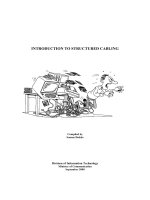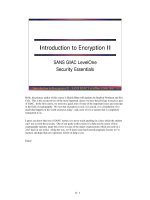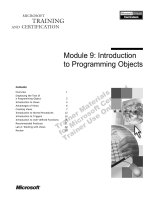Introduction to Organic Chemistry doc
Bạn đang xem bản rút gọn của tài liệu. Xem và tải ngay bản đầy đủ của tài liệu tại đây (638.42 KB, 62 trang )
Chem. Nat. Substances p
Introduction to
Organic Chemistry
Theory Manual
Written by Judy Gordon & Lara Passlow
Chem. Nat. Substances p
Table of Contents
An Introduction to Organic Chemistry 3
Functional Groups 6
Chemical Formulae and the Structures of Organic Compounds 8
Isomers 11
The IUPAC Naming System - How to Name Organic Compounds 12
Hydrocarbons 19
The Alkanes 20
Alkenes and Alkynes 21
Types of Organic Reactions 25
Alkanols (alcohols) 27
Haloalkanes 30
Alkanals and Alkanones 32
Hydrogen Bonding, Polar Functional Groups and Physical Properties 36
Alkanoic (carboxylic) Acids 40
Esters 46
Amines 51
Amides 55
Ethers 56
Aromatics 58
Introduction to Organic Chemistry
Chem. Nat. Substances p3
An Introduction to Organic Chemistry
Organic chemistry is the study of carbon containing compounds and their properties. This
includes the great majority of chemical compounds on the planet, but some substances such
as carbonates and oxides of carbon are considered to be inorganic substances even though
they contain carbon.
Organic chemicals are continually released into the environment in large quantities. For
example, global production of mineral oil exceeds 3 billion tonnes a year and the amount of
new organic chemicals made each year in research laboratories and industry is increasing
exponentially. There is a need to understand how these organic molecules will interact with
the environment in order to minimise their impact. To achieve this the type of reactions that
organic molecules undergo needs to be understood.
How do you tell the difference between an Organic and an Inorganic Compound?
Probably the best way is to compare the chemical and physical properties of substances to the
table below. If they concur with those properties on the left column of the table then the
substance is probably organic, whilst if they compare to the properties listed in the right
column then the substance is most likely inorganic.
Organic Compounds
Inorganic Compounds
Use mostly covalent bonding
Mostly ionic bonding
Are gases, liquids or solids with low melting points
Are generally solids with high melting points
Mostly insoluble in water
Many are water soluble
Many are soluble in organic solvents such as
petroleum, benzene and hexane
Most are not soluble in organic solvents
Solution in water generally do not conduct electricity
When dissolved in water conducts electrical current
Almost all burn
Most not combustible
Slow to react with other chemicals
Often undergo fast chemical reactions
Table 1: Comparison of the properties of organic and inorganic compounds
The vast majority of organic compounds are typically chains or rings of carbon atoms that
contain other elements such as O, N, P, S, Cl, Br and I. There are over five million of these
compounds known today and an almost infinite number of new compounds could possibly be
synthesized. This can be compared to the total number of inorganic compounds, which is
approximately half a million.
Why does carbon form so many compounds?
Carbon has the ability to bond with itself to form long chains and ring structures; hence it can
form molecules that contain from one to an infinite number of C atoms.
Introduction to Organic Chemistry
Chem. Nat. Substances p4
Additionally C atoms may:
be bonded by multiple bonds (i.e. double and triple) as well as single
contain branches of other carbon chains
need additional atoms attached to them to make them stable. The most common of
these is H, but, N, O, X, P and S also commonly occurs attached to C and may even
be attached in several different ways.
Note X is the symbol for any of the halides – F, Cl, Br or I
The Rules for Drawing Organic Molecules
1. C always has four bonds. This may consist of:
4 single
1 double and 2 single
1 triple and 1 single
2 double
2. H always has one bond.
3. O always has two bonds. This may consist of:
2 single
1 double
4. X always has one bond. X = F, Cl, Br or I
5. N always has three bonds. This may consist of:
3 single
1 single and 1 double
1 triple
6. S may have 2, 4 or 6 bonds, but for this course it has 2 bonds.
Introduction to Organic Chemistry
Chem. Nat. Substances p5
Class exercise:
Given 2 carbon atoms and as many hydrogen atoms as required construct 3 possible organic
molecules which contain
(i) 1 oxygen atom (iv) 1 nitrogen atom
(ii) 2 different halogen atoms (v) 1 sulfur, 1 nitrogen, 1 halogen and 1 oxygen.
(iii) 1 sulfur atom
Conclusion –
The number of different design possibilities for organic molecules is endless.
In order to enable classification of such a large number of molecules, organic chemists have
employed the principle of classifying all organic compounds into families according to their
functional groups.
This greatly simplifies the study of organic compounds as molecules with the same functional
groups behave the same in most chemical reactions.
Introduction to Organic Chemistry
Chem. Nat. Substances p6
Functional Groups
The behavior of any molecule in a particular chemical environment is determined by the
stability or reactivity of its bonds. Each different type of bond shows different levels of
reactivity.
Generally in a molecule there is a group of bonds that are more reactive than all the
others and this group tends to determine how the whole molecule behaves in a particular
chemical environment regardless of the structure of the rest of the molecule.
Chemists call these dominant groups of atoms and bonds functional groups and these are
used to classify organic compounds into families.
Understanding the types of reactions that functional groups undergo will enable an
understanding of how an organic molecule interacts with the environment.
A carbon-carbon double bond is an example of a functional group. Organic compounds that
contain a carbon-carbon double bond and no other functional group are called alkenes (a
family name used to classify these compounds). All alkenes react with bromine to yield
dibromoalkanes.
Hence if you know a functional group reacts in one molecule you can predict how it will
react in almost all other molecules.
It is possible to get more than one functional group in a single molecule, but the generalisation
stated above still applies.
Introduction to Organic Chemistry
Chem. Nat. Substances p7
Table 2 (below) contains a list of all the functional groups you are expected to know for this
course.
Type of Functional Group
General Formula
Alkane
-C-C-
Alkene
-C=C-
Alkyne
-C C-
Alkanol (old name alcohol)
C-OH
Amine (Primary)
Amine (Secondary)
Amine (Tertiary)
-C-NH
2
-C-NH-R
-C-N-R
R
Alkanal (old name aldehyde)
C
O
C
H
Alkanone (old name ketone)
C
O
C
C
Amide
N
C
O
R
Ester
C C
O
O
R
Alkanoic acid (also called carboxylic acid)
C
O
OH
Table 2 – Some common functional groups and their general formula.
Note 1: R is the symbol for any hydrocarbon chain.
Note 2: There are many other functional groups besides those listed in Table 1, but these will not be studied in
this course.
Introduction to Organic Chemistry
Chem. Nat. Substances p8
Chemical Formulae and the Structures of
Organic Compounds
How does the chemist know the structure or composition of a particular
chemical substance?
Physical properties enable identification, but give no clues as to the composition
or structure.
Chemical reactivity gives clues as to the functional groups present, but does not
tell the complete structure or chemical composition.
Elemental analysis (through chemical tests and combustion analysis) allows the
determination of the empirical formula of the substance. This expresses the simplest ratio of
the elements present.
For example if there were 6 carbons, 12 hydrogen and 6 oxygen in a compound then the ratio
of each is 6C:12H:6O, but the simplest ratio (read empirical formula) is C:2H:O, which is
obtained by dividing by 6 (the lowest common denominator).
This means that the empirical formula will be CH
2
O.
Class Exercise:
Calculate the empirical formula for each of the substances shown below.
(i) A substance containing 5C‟s, 10H‟s and 5O‟s.
(ii) A substance containing 5C‟s, 10H‟s and 2O‟s.
(iii) A substance containing 6C‟s, 12H‟s and 2O‟s.
Introduction to Organic Chemistry
Chem. Nat. Substances p9
Another formula, the molecular formula expresses the total number of each atom present
and is always a multiple of the empirical formula (it may also be the same as the empirical
formula).
To determine the molecular formula we need to know the molecular mass of the substance.
This is done by dividing the molecular mass by the mass of the empirical formula to obtain a
multiplication factor. The empirical formula is then multiplied by this factor.
e.g. Given a molecular mass of 180 and an empirical formula of CH
2
O calculate the molecular
formula. Data atomic mass of C = 12.00, H = 1 and O = 16.00.
Mass of empirical formula = 12.00 + (2 x 1) + 16 = 30
Molecular mass = 180
Multiplier = 180 / 30 = 6
Molecular formula = empirical formula x multiplier
= CH
2
O x 6
= C
6
H
12
O
6
Once the molecular formula is determined the next step is to determine the molecular
structure that is a representation of how the atoms are bonded to each other. It is
possible to have several different organic compounds with the same molecular formula, but
different molecular structures.
For example given that the molecular formula of a substance was C
2
H
6
O, it is possible to
draw the structure of this molecular formula in two ways (which are shown below). Hence
this formula represents two different organic compounds, with different physical properties.
Ethanol is a liquid at room temperature while methoxy methane is a gas.
CH
3
CH
2
-OH CH
3
-O-CH
3
ethanol methoxy methane
Compounds that have the same molecular formula, but different structural formulas are
known as isomers.
Class Exercise.
Give as many structures as you can for the molecular formula C
4
H
10
O.
Introduction to Organic Chemistry
Chem. Nat. Substances p10
Class Exercise. Representing 3D Organic Structures on Paper
Using the models provided complete the following class exercises:
Shown below is a 2D representation of methane. Study this and the molecular model of
methane provided.
(i) Comment on how the “on page” representation differs from the model, paying
particular attention to the angles of the bonds.
(ii) What do you think the bond angle is in the model?
(iii) Study the model of methane and draw a pictorial representation of the molecule in 3D
using a pencil.
(iv) Use models to build the following molecules:
CH
3
CH
3
CH
2
CH
2
CH
3
CH
3
CH
2
CH
2
What do you notice about these molecules?
(v)Use models to build the following molecules.
C=O
H-C=C-H
H
H
H
H
H-C
C-H
Comment on how the shape of these molecules differs from that of methane. Is it possible to
rotate the double bonds in the same fashion as the single bonds in methane can be rotated?
C
H
H
H
H
Introduction to Organic Chemistry
Chem. Nat. Substances p11
Isomers
Structural Isomers (sometimes called constitutional)
These have the same molecular formulae but differ in the order of connection of atoms.
e.g.
CH
3
CH
2
-OH
CH
3
- O-CH
3
Geometric isomers
They have the atoms bonded in the same order but differ in arrangement of atoms in space.
e.g. cis and trans in alkenes. (Z and E)
C
C
C
C
H
H
HH
R
R'
R
R'
trans cis
Conformational isomers
Due to rotation about C-C bonds.
e.g. Chair and boat formation of cyclohexane.
boat formation chair formation
Introduction to Organic Chemistry
Chem. Nat. Substances p12
The IUPAC Naming (nomenclature) System -
How to Name Organic Compounds
We will use the nomenclature (systematic) system for alkanes and cycloalkanes as a
demonstration of how to systematically name organic compounds. The system used to name
alkanes forms the basis for naming all organic compounds.
The general approach is as follows:
The name given to any compound containing a chain of carbon atoms consists of three parts;
The root of the name which appears in the middle (this is further divided into the
carbon chain designation and the infix),
The prefix which appears at the start; and
The suffix which appears at the end.
Each part will be described, and then some examples examined to show how organic
compound nomenclature works.
1. The Root
This is divided into two sections – the chain designation and the infix.
The chain designation tells us the number of carbon atoms contained in the longest
continuous carbon chain in the molecule. This is based upon the Table given below.
For example if the longest continuous C chain is four the chain designation is but-, if it is
eight it is oct-
Chain Designation
No. of C Atoms
meth-
1
eth-
2
prop-
3
but-
4
pent-
5
hex-
6
hept-
7
oct-
8
non-
9
dec-
10
Table 3. Table of chain designation and corresponding number of carbons. The prefix cyclo- is added to
these chain designations if the carbons exist in ring formation.
Introduction to Organic Chemistry
Chem. Nat. Substances p13
The infix tells us the nature of the carbon bonds. This is based on the system shown in the
table below.
Infix
Nature of Carbon-Carbon Bonds
-an-
only single bonds
-en-
one or more double bonds
-yn-
one or more triple bonds
-yl
attached group (not part of main carbon chain)
Table 4: The infix and corresponding nature of carbon-carbon bonds.
2. The Suffix
This tells us the class of compound to which the substance belongs. It is derived from the
most important functional group in the molecule. The suffixes listed in the table below are
given in their order of importance, the most important at the top, the least at the bottom. If
more than one functional group is in the molecule, it is assigned to that class which has the
more important functional group. In organic chemistry this is based upon the amount of
oxygen and hydrogen in the functional group. Essentially the more oxygen and the less
hydrogen the more important the functional group.
Suffix
Class of Compound
-oic acid
-oate
-al
alkanoic acid
C
O
O HR
ester
C
O
OR R
alkanal
O
C
C
C
-one
alkanone
O
C
C
C
-ol
alkanol
R
C
OH
-e
hydrocarbon
c c
c
Table 5: The suffix and the corresponding class of organic compound.
3. The Prefix
This tells us the other atoms and groups of atoms attached to the main carbon chain. It
may be single species such as halogen atoms, carbon chains smaller than the main carbon
chain, or even rings of carbon atoms.
Introduction to Organic Chemistry
Chem. Nat. Substances p14
The three parts of the name are linked together as shown below:
PREFIX ROOT SUFFIX
Note: In naming, dashes are used to separate numbers and letters; commas are only used to
separate numbers from other numbers. Names are given in one piece; there are no gaps
between the pieces except when specifically stated in the naming system.
Some examples of the naming system are given below.
Example 1
To name this compound
1a. First count the longest continuous carbon chain – in this case 5.
Therefore the chain designation is pent
1b. As the molecule contains only single bonds to the carbon and hydrogen atoms the
infix is an
Therefore the root of the name is pentan
2. Next add the suffix. As this molecule is a hydrocarbon the suffix is just -e.
Therefore the root plus suffix is pentane.
Finally we must list the attached groups as prefixes. In this case there are two groups
attached to the main carbon chain. They are both single carbon groups. When naming
carbon chains that are attached to the main carbon chain, the same naming conventions
are used as in determining the root of the name for carbon designation, but the infix -yl
is employed to distinguish attached chains from the main carbon chain.
In this case the attached groups have only one carbon atom so the chain designation is
meth-, whilst the infix is -yl.
Therefore the attached groups are referred to as methyl groups.
CH
3
CHCH
2
CHCH
3
CH
3
CH
3
Introduction to Organic Chemistry
Chem. Nat. Substances p15
3. If there is any ambiguity as to the position of the attached groups they must be
numbered. The numbering and listing system has the following rules.
the longest continuous carbon chain is numbered such that the most important
functional group is given the lowest number.
the attached groups are listed in alphabetical order.
the number of the carbon atom from the main chain to which the group is
attached is placed in front of the name for the group and a hyphen placed
between them.
if there is more than one type of group attached then the pre-prefixes listed
below are used to state how many of each attached group is present.
Pre-Prefix
Number of Attached Groups
di-
two
tri-
three
tetra-
four
penta-
five
hexa-
six
Table 6: The pre-prefix and the corresponding number of attached groups.
Using the above conventions the attached groups in our example would be 2,4-dimethyl-,
because the one carbon groups are attached to carbons two and four of the main chain and the
pre-prefix di- is used as there are two of them.
So the full name is 2,4-dimethylpentane.
Note: There are no gaps between the parts of the name, only commas to separate the numbers
and hyphens to separate the numbers from the words.
Introduction to Organic Chemistry
Chem. Nat. Substances p16
Example 2.
For the structure
3-methyl-1-butanol
Example 3.
For the structure
3-ethylcyclohexanone
CH
3
OH
CH
3
CHCH
2
CH
2
single carbon group attached at
C number 3
the number 1 tells us which C
the –OH group is attached to
four C in the main chain
the most important functional group is
alkanol
the main C chain contains only
single bonds
O
6C atoms in a ring
main C chain has only single bonds
2 C group attached to C number 3
most important functional group is
alkanone
Introduction to Organic Chemistry
Chem. Nat. Substances p17
Shorthand Notation for Drawing Organic Structures
Organic molecules often appear to have large and complex structures, but in reality they
consist of many simple repeating patterns of CH
3
-, CH
2
-, and CH- groups plus a few others.
Rather than draw oodles (a technical term) of CH
3
and CH
2
groups organic chemists use a
shorthand notation to allow these structures to be drawn very rapidly and simply.
Individual carbon atoms are represented by inflections (read kinks) in a line and the hydrogen
are left out completely. Double and triple bonds are drawn in as required.
For example, CH
3
CH
2
CH
3
is represented as The start, end, and each point of
inflection represent a C atom.
The structure for CH
3
CH
2
CH=CH
2
is
Introduction to Organic Chemistry
Chem. Nat. Substances p18
Class Exercise.
Draw structures for each of the following molecules
(a) pentane (b) 2 -methylpropane
(c) 3-methylheptane (d) 2,2,3-trimethyloctane
(e) 3,5-dimethylheptane (f) 1-ethyl-3-propylcyclohexane
Write correct systematic names for each of the structures (alkanes) given-
(a) (b)
(c) (d)
(e) (f)
Introduction to Organic Chemistry
Chem. Nat. Substances p19
Hydrocarbons
These are compounds composed of carbon and hydrogen. They are generally insoluble in
water although those with lighter molecular masses are gases and are slightly soluble.
Examples of hydrocarbons include methane - the gas we burn as natural gas, propane (also
called liquid petroleum gas) and petroleum jelly.
Hydrocarbons with single carbon-carbon bonds are referred to as being saturated whilst any
hydrocarbon that contains a double bond is said to be unsaturated.
CH
3
CH
2
CH
2
CH
3
H - C = C H
H
H
a saturated hydrocarbn
an unsaturated hydrocarbon
Saturated hydrocarbons are also called the alkanes, whilst the unsaturated hydrocarbons
include both those molecules that contain carbon-carbon double bonds (referred to as the
alkenes) and those that contain carbon-carbon triple bonds (referred to as the alkynes).
Alkanes and alkenes are natural products that have resulted from the decay of organic
compounds from plants and animals that lived millions of years ago. They are found today as
petroleum, which are mixtures of hydrocarbons containing up to 30 or 40 carbon atoms.
Different components of petroleum can be isolated by fractional distillation.
These hydrocarbons are good sources of fuels, the so-called „fossil fuels‟. As mentioned
previously, the global production of such fossil fuels is 3 billion tonnes. As they are produced
in such large quantities, pollution of the environment with these fossil fuels is of concern.
The major route of entry into the environment isn‟t through spectacular disasters such as the
oil spills from ships, but rather through our daily activities. Pumping fuel into cars, and oil
spilled onto the road as a result of old faulty cars are major contributors.
Introduction to Organic Chemistry
Chem. Nat. Substances p20
The Alkanes
This family of compounds consists of substances that contain only carbon and hydrogen
joined by single bonds. They obey the general formula
C
n
H
2n
+ 2
Thus if an alkane has six carbons, its formula will be C
6
H
14
. The simplest alkane is methane,
CH
4
. Methane is also the most abundant organic species in the atmosphere. It is produced
mainly by organisms breaking down organic material in places such as marshes, lake bottoms,
land fills and the stomach of ruminant animals.
Reactions of Alkanes
Because they are saturated compounds and because the C-C and C-H bonds are relatively
strong, the alkanes are fairly unreactive, (e.g. at room temperature they do not react with
acids, bases, or strong oxidising agents) which makes them invaluable as lubricants and the
backbone of plastics.
At sufficiently high temperatures, alkanes react vigorously with oxygen. This is known as a
combustion reaction and is the basis for their widespread use as fuels. An example is the
reaction of butane with oxygen.
Class Exercise.
See if you can write the correct equation for the combustion of butane in oxygen to give water
plus carbon dioxide.
The production of carbon dioxide in the environment is of concern because it has been
implicated in the green house effect. Animals and plants produce carbon dioxide.
Recently there has been an increase in carbon dioxide production brought about by a
combination of deforestation and the burning of fossil fuels. (Plants use up carbon dioxide in
photosynthesis, so removing vegetation is a good way to increase the amounts of carbon
dioxide in the atmosphere). Carbon dioxide is thought to act like a blanket placed over the
earth, it captures infrared radiation and transforms it into heat (The so-called “Green House
Effect”). This may lead to an increase in the earth‟s temperature, which may cause a melting
of the earth‟s ice caps. This could have potentially devastating effects, particularly for people
who live in seaside cities.
Alkanes also under-go reactions induced by UV light. Examples include the slow
breakdown of plastics in the sun, and halogenation reactions (reactions where halogen atoms
such as Cl, Br, or I replace H in the molecule).
Introduction to Organic Chemistry
Chem. Nat. Substances p21
Alkenes and Alkynes
When hydrogen is removed from an alkane multiple carbon-carbon bonds result.
Hydrocarbons that contain a carbon-carbon double bond are called alkenes, and have the
general formula
C
n
H
2n
The simplest alkene is ethene (also known as ethylene) (C
2
H
4
). Ethylene is emitted by green
plants in substantial quantities. It has hormonal activity and has been implicated in the
control of many physiological processes in plants. The natural atmospheric concentration of
ethylene is low due to its high reactivity with ozone and other atmospheric chemicals, but in
polluted environments concentrations can be much higher. It is a product of the combustion
of wood, coal, oil, natural gas and petroleum.
Hydrocarbons that contain a carbon-carbon triple bond are called alkynes. These
compounds have the general formula
C
n
H
2n-2
The simplest alkyne is ethyne (which is also known as acetylene) which has the formula
C
2
H
2
. Ethyne is a flammable and explosive gas, when burnt in the presence of oxygen
enough heat is produced to cut and weld metals (the basis of the oxyacetylene welding torch).
Alkynes are not normally found in the environment because they are highly reactive.
Introduction to Organic Chemistry
Chem. Nat. Substances p22
Nomenclature of Alkenes and Alkynes
The systematic nomenclature for alkenes is quite similar to that for alkanes. Important
differences are listed below.
The root hydrocarbon name ends in -ene rather than -ane.
In alkenes with more than three carbon atoms, the lowest numbered carbon atom
involved in the double bond indicates the location of the double bond.
Thus CH
2
=CHCH
2
CH
3
is called 1- butene, and CH
3
CH=CHCH
3
is called 2 - butene.
The restricted rotation around a double bond means that alkenes exhibit cis-trans isomerism
(they have the same molecular formula but different structural formula). For example in the
case of 2 - butene we can draw structures (a) and (b) below. Identical substituents in the same
side of the double bond are referred to as cis- (or Z), whilst identical substituents on the
opposite side of the double bond are designated trans- (or E). Hence structure (a) is called
cis-2-butene, whilst structure (b) is called trans-2-butene. Cis-trans isomers have different
physical properties.
(a) bp = 4C, mp = -113C (b) bp = 1C, mp = -106C
The nomenclature for alkynes involves the use of -yne as a suffix to replace the -ane of the
parent alkane. Thus the molecule CH
3
CH
2
C=CCH
3
has the name 2-pentyne.
Physical and Chemical Properties of Alkenes and Alkynes
Physical Properties
The physical properties of alkenes and alkynes are very similar to alkanes with the same
number of carbon atoms and branching pattern.
Chemical Properties
Unlike alkanes, which are fairly inert, alkenes and alkynes undergo many chemical
reactions. These reactions take place at the multiple carbon-carbon bonds and are called
addition reactions.
An example of an addition reaction to an alkene.
C C
CH
3
CH
3
C C
CH
3
CH
3
C C
+ AB
C C
A
B
Introduction to Organic Chemistry
Chem. Nat. Substances p23
ADDITION REACTIONS OF ALKENES
HYDROGENATION H H
C – C
H
2
/ Pt H H
alkane
HYDRATION H H
C – C -
H
+
/ H
2
O H OH
alkanol
TRANS (E)
ADDITION.
HALOGENATION X H
C – C -
X
2
H X
C=C dihaloalkane
HYDROHALOGENATION H H
C – C -
HX X H
haloalkane
HYDROXYLATION H H
C – C -
KMnO
4
/ H
2
O HO OH
diol
CIS (Z)
ADDITION.
HYPOHALOGENATION H H
C – C -
HOX HO X
haloalkanol
POINTS TO NOTE.
a. Trans (E) and Cis (Z) addition.
b. Markovnikov addition to unsymmetrical alkenes by unsymmetrical reagents i.e. the non-
hydrogen part adds to the more substituted carbon (with HO the OH adds to the more
substituted carbon)
ALKENE
Introduction to Organic Chemistry
Chem. Nat. Substances p24
MARKOVNIKOV’S RULE.
In an addition reaction, where the reagent being added to the double bonds
is unsymmetrical (e.g. HCl), there can be two possible products, depending
on which end of the double bond is attacked by the two components of the
reagent.
Markovnikov’s rule states that the negative part of the reagent bonds
to the end of the C=C, which has the LEAST number of hydrogens.
The negative component is normally the non-H part, except in HOX, where
it is OH.
Introduction to Organic Chemistry
Chem. Nat. Substances p25
Types of Organic Reactions
1. Addition
C
C
C
C
C
C
[
]
A B
A
B
The double bond dissolves back to single bond and new bonds reach out to A and B whose
bond is also dissolving
A – B can be.
H-H H-OH H-X X-X OH-OH OH-X
Draw the product of each of these examples of A-B when they add to 1-propene.
C = C
CH
3
H
H
H









